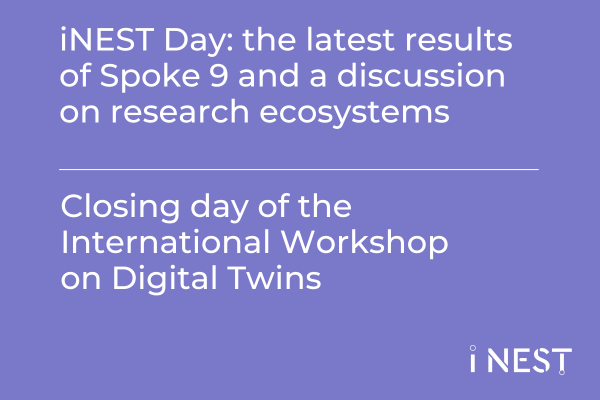
iNEST Day: the latest results of Spoke 9 and a discussion on research ecosystems
4 scientific sessions and a round table enlivened the closing day of the International Workshop on Digital Twins
Padua, 21st February 2025
The iNEST Day, the final event of the three-day International Workshop on Digital Twins: Mathematical Analysis, Formal Methods, and Scientific Machine Learning, took place today. It was an opportunity to showcase the value of Spoke 9 and iNEST to an international audience. The morning featured a rapid presentation of research findings, followed by a round table on the role and function of interconnected research ecosystems. Four scientific sessions took place in the afternoon—one for each Research Topic of Spoke 9.
RT1: mathematics and computer science to create models
“Our goal is to produce effective models, both from a theoretical and a practical point of view.” These were the words of Prof. Antonia Larese from the University of Padua, who presented the results of Research Topic 1, focused on the development of data-driven mathematical and numerical models. In the afternoon, Mattia Fogagnolo (UniPD) discussed some challenges related to the mathematical study of water distribution systems. Indeed, it is one of the main fields in which Digital Twins are employed. Following this, Matteo Zavatteri (UniPD) explored specific types of neural networks designed within the context of iNEST.
RT2: how to make simulations quicker
In the morning, Niccolò Tonicello from SISSA presented Research Topic 2, which focuses on Model Order Reduction (MOR) techniques. “The simulation of complex systems can be computationally expensive. MOR accelerates this process, paving the way for real-time simulation while still keeping it accurate”, he stated. Tonicello’s presentation was followed by two afternoon talks: in the first one, he discussed challenges in applying MOR to turbulent flows. In the latter, Guglielmo Padula (SISSA) introduced a MOR model for Digital Shadows, digital replicas of real-world systems that receive a continuous data stream.
RT3: AI for Digital Twins
“We want to integrate automatic learning techniques and artificial intelligence to achieve efficient, real-time simulation.” This is what Francesca Cairoli from the University of Trieste stated during the presentation of the results of Research Topic 3, which focuses on using machine learning in developing Digital Twins. During the dedicated scientific session, Francesco Giacomarra (UniTS) presented an innovative approach for Deep Generative Models—AI models that combine Deep Learning (DL) with probabilistic modeling to generate data similar to a given set. Following this, Federico Camerota Verdù (UniTS) showcased a strategy to optimize Deep Reinforcement Learning algorithms, which combine DL with the reward and penalty system of Reinforcement Learning.
RT4: applications, from oceans to Earth
Stefano Salon from OGS provided an overview of the results of Research Topic 4, which investigates Digital Twin applications. ”We want to gather and showcase many use cases of Digital Twins. One of them is, for example, the forecasting of the Mediterranean Sea”, he declared. Expanding on Salon’s presentation, two talks followed in the dedicated scientific session in the afternoon: Federica Adobbati (OGS) discussed Deep Learning models for mathematical modeling of the oceans. Finally, Stefano Campanella (OGS) focused on the creation of Earth models.
iNEST and companies: building an ecosystem to develop Digital Twins
The highlight of the iNEST Day was the morning round table, a stimulating discussion featuring Prof. Franco Bonollo (President of the iNEST Consortium), Prof. Angelo Montanari (President of the iNEST Scientific Committee), Eng. Luca Fabbri (General Director of iNEST), Cristina Scarpel from Almaviva Bluebit, and Giacomo Gentile from Collins Aerospace. At the heart of the debate, once again, were Digital Twins. “Supporting the implementation of DTs in small and medium enterprises is one of the major challenges of iNEST” emphasized Prof. Bonollo, highlighting the need to make this technology increasingly accessible and practical.
But what are the real benefits and challenges of adopting Digital Twins in industry? The representatives of the two companies focused on a key element: data. “Collecting large amounts of data is one of the greatest strengths of DTs,” explained Gentile. “It is hard to find an industrial sector where they do not have concrete applications.”
“In our case, the real challenge is obtaining reliable real-world data. Digital Twins provide us with exactly that,” added Scarpel.
Even in the case of DTs, the key to connecting research and industry lies in the ability to build an ecosystem, as emphasized by Prof. Montanari: “Companies developing Digital Twins operate in different sectors but often face the same challenges. The key is to work together, leveraging the general framework developed by universities and adapting it to the specific needs of industries.”













